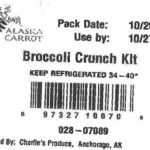Potatoes aren't often thought of when people think about food poisoning. This root vegetable is, after all, always cooked before it's eaten, which would kill off any pathogenic bacteria. But this vegetable grows in soil and can be contaminated at any point along the supply chain. But there have been some outbreaks linked to potatoes. Clostridium botulinum outbreaks have been linked to baked potatoes that are wrapped in aluminum foil. The spores that produce this deadly toxin are found in the soil, and they can contaminate the spuds. The spores can sometimes survive the baking process. If the potatoes are baked while tightly wrapped in aluminum foil, that creates an anaerobic (oxygen-free) environment. And that creates the perfect conditions for botulism spores to germinate, grow, … [Read more...]
Google FINDER Search May Pinpoint Restaurants Associated with Food Poisoning Outbreaks
Google and Harvard University have developed a new method for identifying restaurants that may be the source of food poisoning outbreaks much more quickly than traditional methods. The method is called FINDER (Foodborne IllNess DEtector in Real time), which uses web search and location data. Most food poisoning outbreaks are linked to restaurants and delis. Traditionally, foodborne illness outbreaks are investigated after people go to the doctor when they are sick. Officials then interview those patients to see if there is a common denominator in what they ate or where they ate before they got sick. Or officials are alerted to a potential outbreak through PulseNet, which is an aggregate of bacterial DNA taken from ill persons and categorized. What is FINDER? FINDER is actually … [Read more...]
Who is at High Risk for Complications From Food Poisoning?
Every week Food Poisoning Bulletin tells you about outbreaks that have sickened, hospitalized, or even killed dozens and hundreds of people. The ironic thing about these outbreaks is that a good number of sick persons never see a doctor. Unless something goes seriously wrong. So who is at higher risk for developing serious complications from food poisoning? Every year, about 1 in 6 Americans, or 48,000,000 people, contract some type of food poisoning infection. More than 120,000 are hospitalized, and 3,000 people die. Those who are more likely to get a foodborne illness in the first place are children under the age of 5, adults over the age of 65, anyone who has a chronic illness such as cancer or diabetes, and pregnant women. That's why we stress that it is so important to … [Read more...]
CDC Surveillance Report Reveals Outbreak Numbers, But Not Consequences of Foodborne Illness
The CDC Surveillance Report for Foodborne Disease Outbreaks from 2009 - 2015 was released in the Morbidity and Mortality Weekly Report today. The numbers show that food poisoning outbreaks remain a serious health problem in this country, causing millions of illnesses every year. But what the raw numbers don't reveal is how these largely preventable illnesses wreak havoc on individual lives and families. During the time frame of the report, the CDC's Foodborne Disease Outbreak Surveillance System received reports of 5,760 outbreaks that caused more than 100,000 illnesses, more than 5500 hospitalizations, and 145 deaths. These outbreak illnesses are a small fraction of the actual number of food poisoning cases that occur every year. The government estimates that 48,000,000 … [Read more...]
Iowa Warns About Use of Copper Mugs with Alcoholic Beverages
The State of Iowa has issued an advisory bulletin warning consumers about selling and serving alcoholic beverages in copper mugs. There are federal guidance and state regulations about the use of copper and copper alloys in contact with food and beverages. The popularity of a drink called Moscow Mule, an alcoholic cocktail that is typically served in a copper mug, has led to inquiries about the safe use of these mugs. The use of copper and copper alloys as a food contact surface is limited in Iowa. That state and many other states have adopted the Federal Food and Drug Administration’s Model Food Code, which prohibits copper from coming into direct contact with foods that have a pH below 6.0. Examples of foods with a pH below 6.0 include vinegar, fruit juice, or wine. Since the … [Read more...]
Mushroom Poisoning in California Subject of MMWR
The June 2, 2017 edition of the CDC's Morbidity and Mortality Weekly Report has a study about mushroom poisoning in California. In December 2016, fourteen cases of Amanita phalloides poisoning were identified by the California Poison Control System (CPCS) among people who had consumed foraged wild mushrooms. All of the patients in this outbreak had the symptoms of mushroom poisoning. Three of the patients had to have liver transplants. All of the patients have since recovered, although one child had permanent neurologic impairment. The report recommends that all wild-picked mushrooms should be evaluated by a trained mycologist before they are eaten. Inexperienced foragers should be "strongly discouraged" from eating any wild mushrooms. And health care providers should be aware of … [Read more...]














